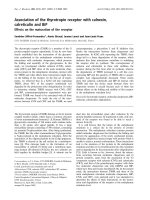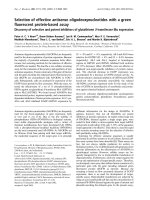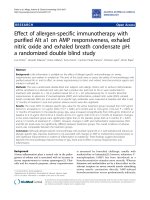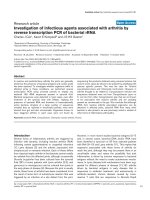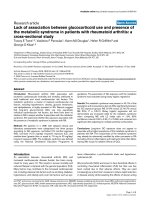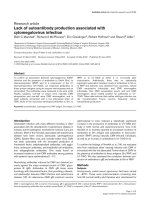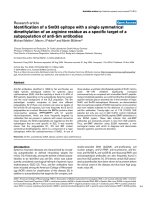Báo cáo y học: "Lack of autoantibody production associated with cytomegalovirus infection" pdf
Bạn đang xem bản rút gọn của tài liệu. Xem và tải ngay bản đầy đủ của tài liệu tại đây (48.97 KB, 5 trang )
Introduction
Antecedent infection with many different microbes is often
associated with the development of autoimmune disease in
humans, but the pathogenic mechanisms involved, if any, are
unknown. Most of the microbes associated with autoimmune
disease have been viruses, particularly cytomegalovirus
(CMV), Epstein–Barr virus, and varicella–zoster virus. CMV
has been associated with the increased production of
rheumatoid factor, antiphospholipid antibodies, cold agglu-
tinins, antimyosin antibodies, anti-endothelial cell antibodies,
and antiganglioside antibodies. One study found an
increased incidence of anti-CMV antibodies among patients
with systemic lupus erythematosus [1–11].
Neutralizing antibodies induced by CMV are directed pri-
marily against the major envelope protein of CMV, glyco-
protein B (gB). Antibodies to CMV gB share some
homology with rheumatoid factor, thus providing a theoret-
ical relationship between CMV infection and autoimmune
disease [12]. An adenovirus–CMV gB construct vaccine
administered to mice induced a statistically significant
increase in the production of antibodies to U1-70kD anti-
body in both normal and autoimmune-prone mice [13].
Newkirk et al. recently reported an increased incidence of
antibodies to Sm antigen and antibodies to ribonucleo-
protein (RNP) among naturally CMV-infected individuals,
as well as an increase in antibodies to U1-70kD [14].
To confirm the findings of Newkirk et al. [14], we evaluated
sera from individuals either naturally infected with CMV or
immunized with the live attenuated Towne strain of CMV for
the presence of antibodies to three antigens: Sm, RNP, and
U1-70kD. We also assessed the correlation between pro-
duction of antibodies to gB and antibodies to Sm or RNP.
Methods
Subjects
Anonymously coded serum specimens had been stored
at –80°C. These were preimmunization screening sera
from 80 normal healthy adult females who volunteered for
CMV = cytomegalovirus; EIA = enzyme immunoassay; gB = glycoprotein B; OD = optical density; RNP = ribonucleoprotein; Sm = ribonucleopro-
teins recognized by antibodies from a patient named Smith; U1-70kD = component of the U1 ribonucleoproteins.
Available online />Research article
Lack of autoantibody production associated with
cytomegalovirus infection
Beth C Marshall
1
, Richard A McPherson
2
, Eric Greidinger
3
, Robert Hoffman
3
and Stuart P Adler
1
1
Department of Pediatrics, Virginia Commonwealth University/Medical College of Virginia, Richmond, Virginia, USA
2
Department of Pathology, Virginia Commonwealth University/Medical College of Virginia, Richmond, Virginia, USA
3
Department of Internal Medicine, University of Missouri, Columbia, Missouri, USA
Corresponding author: Stuart P Adler (e-mail: )
Received: 21 March 2002 Revisions received: 2 May 2002 Accepted: 20 May 2002 Published: 20 June 2002
Arthritis Res 2002, 4:R6
© 2002 Marshall et al., licensee BioMed Central Ltd (Print ISSN 1465-9905; Online ISSN 1465-9913)
Abstract
To confirm an association between cytomegalovirus (CMV)
infection and the presence of antibodies to Smith (Sm), to
ribonucleoprotein (RNP), and to a component of the U1
ribonucleoproteins (U1-70kD), we measured antibodies to
these protein antigens using an enzyme immunoassay and an
immunoblot. The antibodies were measured in the sera of 80
healthy subjects, one-half of whom were naturally CMV
seropositive and one-half were CMV seronegative, and in
eight subjects immunized with a live attenuated strain of
CMV. None of the vaccinees developed antibodies to Sm, to
RNP, or to U1-70kD at either 4 or 12 months after
immunization. Additionally, there was no statistically
significant association between levels of antibodies to Sm or
to RNP and between sera obtained from vaccinees, natural
CMV seropositive individuals, and CMV seronegative
individuals. One CMV seropositive serum and one CMV
seronegative serum tested positive for antibodies to U1-
70kD. These data indicate that neither wild-type infection nor
the live-attenuated Towne vaccine frequently induce
autoantibody production.
Keywords: autoantibodies, cytomegalovirus, RNP antigen, Sm antigen, U1-70kD
Page 1 of 5
(page number not for citation purposes)
Page 2 of 5
(page number not for citation purposes)
Arthritis Research Vol 4 No 5 Marshall et al.
a Towne vaccine study. Forty naturally seropositive and
40 seronegative sera were used. Subjects were aged
between 20 and 53 years (the ages of four individuals
were not recorded). Also included were postimmunization
serial sera from eight normal healthy women who had
received 6000 plaque forming units of the live attenuated
Towne vaccine as a single subcutaneous injection. Fol-
lowing immunization, all eight subjects developed anti-
bodies to CMV and to CMV gB. Seventy-five per cent of
the CMV seropositive subjects and 85% of the CMV
seronegative subjects were Caucasian; the remainder
were Afro-American.
Screening for anti-CMV antibodies
Sera were tested for the presence or absence of IgG anti-
bodies to CMV by either latex agglutination (CMVScan;
Becton Dickinson, Sparks, MD, USA) or by enzyme
immunoassay (EIA) as previously described [15].
Detection of antibodies against Sm and RNP
An indirect, noncompetitive EIA was used for both Sm and
RNP antigens to detect IgG antibodies. Microplate wells
coated with antigen bound human antibody, which was
subsequently bound by an enzyme-labeled conjugate anti-
body and quantitated colorimetrically (Varelisa; Pharmacia
& Upjohn, Freiburg, Germany). Sera were diluted 1:101
for both assays.
The Sm antigen used in this assay was purified from calf
thymus. The human recombinant RNP antigens used
included the U1-70k, U1A, and U1C antigens. For both
Sm and RNP, specific quantitative values for each speci-
men were obtained by extrapolation of optical densities
(OD) from a standard curve derived from six points. For
Sm, the negative/positive cutoff value was 10 IU/ml serum
or OD = 0.52. For RNP, the negative/positive cutoff value
was 5 IU/ml serum or OD = 0.32.
Detection of antibodies to U1-70kD
To detect the presence of IgG antibodies to the U1-70kD
ribonuclear protein, both immunoblotting and EIA methods
were used as described previously [16–18]. Each sample
was tested by immunoblot against Jurkat cell lysates with
a 1:100 dilution of sera, and by EIA against a bacterially
produced U1-70kD fusion protein that comprised
residues 1–205 of u1-70kD. All EIA assays were per-
formed using a serum dilution of 1:1000 and were run
taking the average OD of duplicate wells. EIA results were
repeated for any samples where the OD of the duplicate
wells varied by more than 0.05, and for all samples with
positive results by either EIA or immunoblot. In cases
where discrepant results were obtained between
immunoblot and EIA testing, sera were immunoblotted
using a more sensitive technique against both intact and
apoptotic Jurkat lysates, as previously described [18,19]
using sera diluted 1: 5000.
Negative immunoblot and EIA results demonstrated the
absence of significant titers of IgG antibodies to U1-
70kD. Positive results on immunoblot and EIA or a posi-
tive result on one of these two tests and a positive
immunoblot for apoptotic U1-70kD demonstrated the
presence of antibodies to U1-70kD. A positive
immunoblot result that was not confirmed by EIA or
follow-up immunoblot would probably reflect recognition
of an antigen other than U1-70kD with similar elec-
trophoretic motility (i.e. a negative result). An isolated
positive EIA was an indeterminate finding; the weaker the
recognition, the less likely it was to be valid. A positive
EIA result was an OD value above 0.100. If either the EIA
or the immunoblot produced positive results, the more
sensitive apoptotic assay was used to verify the presence
of antibodies to U1-70kD. The sensitivity of these assays
has been previously established [16–19].
Detection of antibodies to gB
Quantitative levels of antibodies against CMV gB were
measured by EIA in all seropositive sera as previously
described [20]. The OD value obtained for the 1:1600
dilution for each serum was used for statistical calcula-
tions. The gB antigen used in this assay was a recombi-
nant derivative of human CMV strain Towne gB
produced as a secreted protein in Chinese hamster
ovary cells [21]. The recombinant gB includes amino
acids 1–676 of the extracellular domain. The proteolytic
cleavage site at amino acid 437 was blocked by the
site-specific mutation of amino acid residues 433, 434,
and 436 [22].
Statistical calculations
Comparisons were carried out using Student’s t test or
chi-square analysis. Regression analysis was performed
using Sigma Plot (version 1.02; Jandel Corporation, San
Rafael, CA, USA).
Results
Antibodies against Sm and RNP
Using the manufacturer’s sera to establish a negative/pos-
itive cutoff value, none of the sera tested contained
detectable levels of antibodies to either Sm or RNP
(Table 1). For Sm, using the mean OD plus two standard
deviations (Table 1) of the 40 CMV seronegative sera to
establish a negative/positive cutoff value, none of the 40
CMV seropositive sera were positive, one of the CMV
seronegative sera was positive (OD = 0.422), and none of
the sera from the vaccine recipients were positive. For
RNP, using the mean OD plus two standard deviations
(Table 1) of the 40 CMV seronegative sera to establish a
negative/positive cutoff value, two of the 40 CMV
seronegative sera were positive (OD = 0.22 and 0.30),
three of the CMV seropositive sera were positive
(OD = 0.25, 0.26 and 0.25), and none of the sera from the
vaccine recipients were positive.
Page 3 of 5
(page number not for citation purposes)
To determine whether there was a statistically significant
association between levels of antibodies to CMV gB and
the levels of antibodies to Sm antigen or RNP antigen, a
simple linear regression analysis of gB OD values versus
Sm and RNP OD values for sera from CMV seropositive
subjects and for sera from vaccines at 4 and 12 months
after immunization was performed. No significant correla-
tions were found (Table 2).
Antibodies against U1-70kD
Using the EIA with U1-70kD as the antigen, only one of
104 sera tested was positive (OD = 0.121). That one
serum was negative using an immunoblot with apoptotic
Jurkat cells. Using an immunoblot, three of 104 sera were
positive and three sera were weakly positive. None of the
three weakly positive sera were positive using an
immunoblot with apoptotic Jurkat cells, but two of the
three sera positive by immunoblot were also positive using
an immunoblot with apoptotic Jurkat cells. No sera was
positive both by immunoblot and by EIA. There was no sig-
nificant difference for the rate of positivity between sera
obtained for CMV seropositive subjects and CMV
seronegative subjects (Table 3). None of the recipients of
CMV vaccine developed antibodies to U1-70kD (Table 3).
Discussion
The present study was designed to confirm the report of
Newkirk et al. They reported that, among the sera of 100
normal healthy adults (50 CMV seropositive and 50 CMV
seronegative), 54% contained antibodies to RNP, 50%
contained antibodies to Sm, and 33% contained antibod-
ies to U1-70kD [14].
Available online />Table 1
Association between cytomegalovirus (CMV) infection and antibodies to Smith (Sm) and to ribonucleoprotein (RNP)
Subjects Sm antigen RNP antigen
CMV negative 0/40(0.067 ± 0.143) 0/40 (0.116 ± 0.091)
CMV positive 0/40 (0.067 ± 0.095) 0/40 (0.128 ± 0.097)
CMV vaccinees
Preimmunization 0/8 (0.055 ± 0.051) 0/8 (0.114 ± 0.036)
4 months postimmunization 0/8 (0.056 ± 0.032) 0/8 (0.117 ± 0.041)
12 months postimmunization 0/8 (0.050 ± 0.028) 0/8 (0.111 ± 0.048)
Data presented as number positive/total* (mean optical density ± two standard deviations). * The negative/positive cutoff value used was
established by standard sera provided by the manufacturer (see text).
Table 2
Association between antibody levels to cytomegalovirus (CMV) glycoprotein B (gB) and antibody levels to Smith (Sm) and to
ribonucleoprotein (RNP) in seropositive sera
Statistical correlation with optical density to:
Sm RNP
Subjects EIA optical density to gB (mean ± SD) Rt P R tP
CMV seropositive (n = 40) 1.152 ± 1.01 0.118 0.735 0.234 0.214 1.351 0.092
Vaccinees (n = 8)
4 months postimmunization 1.479 ± 2.46 0.147 0.332 0.376 0.147 0.365 0.364
12 months postimmunization 0.690 ± 1.18 0.571 1.702 0.070 0.062 0.153 0.442
EIA, enzyme immunoassay; SD, standard deviation.
Table 3
Association between cytomegalovirus (CMV) infection and
autoantibodies to a component of the U1 ribonucleoproteins
(U1-70kD)
Subjects Number positive*/total
CMV seronegative 1/40
CMV seropositive 1/40
Vaccinees
Preimmunization 0/8
4 months postimmunization 0/8
12 months postimmunization 0/8
* All sera positive were positive by immunoblot (see text).
Newkirk et al. also observed that the frequency of auto-
antibodies to each of the antigens occurred more frequently
among CMV seropositive subjects than among CMV
seronegative subjects[14]. For CMV seropositive sub-
jects, they observed that 42 (84%) subjects had anti-
bodies to RNP, 32 (64%) had antibodies to Sm, and 23
(46%) had antibodies to U1-70kD [14]. If Newkirk et al.
used a negative/positive cutoff value of the mean plus
three standard deviations then, overall, less than 10% of
their sera contained autoantibodies.
We could not reproduce the data of Newkirk et al. The
subjects in the study of Newkirk et al. were similar to our
subjects; 80% female and 98% Caucasian. Although
there are only a few published reports on the frequency of
these antibodies in normal populations, those published
reports all find a frequency of between 0 and 3%, similar
to those reported in the present study [23–27]. One study
of over 1000 healthy pregnant and nonpregnant Israeli
women found that none had IgG antibodies to either Sm
or RNP. IgM antibodies, however, were detected in 4% or
less of subjects. Patients with autoimmune disease have
predominantly IgG antibodies to Sm and to RNP, and to a
lesser extent IgM antibodies, whereas patients with inac-
tive autoimmune disease are most likely to have IgM anti-
bodies to these antigens [28,29]. Both the present study
and that of Newkirk et al. measured IgG antibodies to
these nuclear antigens.
Several factors may account for the difference between
our results and those of Newkirk et al. Differences in assay
methods or antigens could be important. This is sug-
gested by the fact that the mean OD (> 0.5) observed by
Newkirk et al. in their Sm and RNP EIA assays was signifi-
cantly higher than the mean OD (< 0.15) observed in the
present study. Another possibility relates to the
negative/positive cutoff value used. For all three antigens,
Newkirk et al. used EIA assays and established their nega-
tive/positive cutoff value using the mean plus two standard
deviations of 15 CMV seronegative sera [14]. This
appears to have resulted in a negative/positive cutoff value
significantly lower than that observed in the present study
using either the manufacturer’s recommended cutoff value
or our own cutoff value established with the 40 seronega-
tive sera. To detect antibodies to U1-70kD, Newkirk et al.
used only an EIA assay. Using the EIA assay, we found
only one of 104 sera contained antibodies to this protein.
Another factor that may account for the difference between
our results and those of Newkirk et al. is the prevalence of
the HLA antigen DR4. This HLA type occurs among 60%
of patients with autoimmune disease and antibodies to U1-
70kD, but its prevalence in the normal healthy individuals is
only about 25% [16,30]. Hence, if the association between
HLA DR4 and the presence of antibodies to U1-70kD
exists for healthy individuals and if, due to selection bias,
our population contained very few (< 4%) DR4-positive
individuals and the population of Newkirk et al. contained a
very high (≥ 50%) prevalence of DR4-positive subjects, this
could account for the observed differences. This possibil-
ity, however, seems very improbable.
In another study, Newkirk and coworkers also observed
that a recombinant gB vaccine, which expressed the gB
protein of the Towne vaccine, induced antibodies to CMV
gB when administered to mice, suggesting that CMV gB
induces antibodies crossreactive to U1-70kD [13]. If this is
the case, it predicts a correlation between levels of anti-
bodies to gB and U1-70kD in sera. In humans, neither the
present study or that of Newkirk and colleagues [13] found
such a correlation. This indicates that either there is no
such crossreactivity or that, if it exists, it occurs very infre-
quently or only to a few epitopes. It is also possible that the
mice Newkirk and coworkers used were genetically primed
to produce autoantibodies in response to this antigen.
Whether viruses cause autoimmune disease is controver-
sial. If they do cause disease, several mechanisms may
explain the association between viruses and autoimmune
disease. To stimulate a complete autoimmune response,
two signals (one antigen specific and one not antigen
specific), are necessary [31]. The best described antigen-
specific mechanism is molecular mimicry, whereby some
component of the offending virus resembles the host
structure on a molecular level, thus providing the template
for antibody formation that may crossreact with self-
antigen. Several of the nonantigen-specific signals include
costimulatory cell surface markers as well as the genera-
tion of a multitude of cytokines. Theoretically, viruses may
play a role in eliciting either or both of these signals.
Infection with CMV is ubiquitous within the human popula-
tion, and nearly 100% of humans eventually acquire a
CMV infection. On the contrary, autoimmune disease is
relatively rare, occurring in less than 5% of the population.
If CMV was a frequent inducer of autoantibodies, and by
implication an autoimmune disease, both the frequency of
autoantibodies in disease-free individuals and the inci-
dence of autoimmune disease in the general population
would be much higher than observed by other workers
and ourselves. It is not excluded, however, that a low fre-
quency of these three autoantibodies may be infrequently
but significantly associated with CMV infection. To estab-
lish this will require testing of a large number of sera. For
example, testing of nearly 700 sera will be required to
determine whether an autoantibody frequency of 5%
among CMV seropositive individuals and of 1% among
CMV seronegative individuals is a significant difference.
Conclusion
We failed to detect antibodies to either Sm or RNP in indi-
viduals infected with wild-type CMV or in eight individuals
Arthritis Research Vol 4 No 5 Marshall et al.
Page 4 of 5
(page number not for citation purposes)
vaccinated with the Towne strain of CMV. Likewise,
regression analysis of levels of antibodies to CMV gB, the
major antibody formed after natural infection or active
immunization, failed to demonstrate a correlation with the
levels of antibodies to Sm and to RNP. With regards to
antibody to U1-70kD, which may be a more sensitive indi-
cator of autoimmune disease, the sera from only one CMV
seropositive subject contained these antibodies and none
of the sera of the vaccinees contained these antibodies.
These results indicate that CMV infection induces these
autoantibodies infrequently and that autoimmune disease
associated with CMV infection is probably rare.
Acknowledgments
The authors acknowledge the technical assistance of Sue Hempfling
and Brian Barnstein.
References
1. Ferraro AS, Newkirk MM: Correlative studies of rheumatoid
factors and anti-viral antibodies in patients with rheumatoid
arthritis. Clin Exp Immunol 1993, 92:425-431.
2. Newkirk MM, Gram H, Heinrich GF, Ostberg L, Capra JD,
Wasserman RL: Complete protein sequences of the variable
regions of the cloned heavy and light chains of a human anti-
cytomegalovirus antibody reveal a striking similarity to human
monoclonal rheumatoid factors of the Wa idiotypic family.
J Clin Invest 1988, 81:1511-1518.
3. Baldwin WM 3rd, Westedt ML, van Gemert GW, Henny FC, Paul
LC, Daha MR, van Es LA: Association of rheumatoid factors in
renal transplant recipients with cytomegalovirus infection and
not with rejection. Transplantation 1987, 43:658-662.
4. Mengarelli A, Minotti C, Palumbo G, Arcieri P, Gentile G, Iori AP,
Arcese W, Mandelli F, Avvisati G: High levels of antiphospho-
lipid antibodies are associated with cytomegalovirus infection
in unrelated bone marrow and cord blood allogeneic stem cell
transplantation. Br J Haematol 2000, 108:126-131.
5. Labarca JA, Rabaggliati RM, Radrigan FJ, Rojas PP, Perez CM,
Ferres MV, Acuna GG, Bertin PA: Antiphospholipid syndrome
associated with cytomegalovirus infection: case report and
review. Clin Infect Dis 1997, 24:197-200.
6. Lawson CM, O’Donoghue HL, Reed WD: Mouse cytomegalo-
virus infection induces antibodies which cross-react with
virus and cardiac myosin: a model for the study of molecular
mimicry in the pathogenesis of viral myocarditis. Immunology
1992, 75:513-519.
7. Toyoda M, Galfayan K, Galera OA, Petrosian A, Czer LS, Jordan
SC: Cytomegalovirus infection induces anti-endothelial cell
antibodies in cardiac and renal allograft recipients. Transpl
Immunol 1997, 5:104-111.
8. Toyoda M, Petrosian A, Jordan SC: Immunological characteriza-
tion of anti-endothelial cell antibodies induced by cyto-
megalovirus infection. Transplantation 1999, 15:1311-1318.
9. Ang CW, Jacobs BC, Brandenburg AH, Laman JD, van der
Meche FG, Osterhaus AD, van Doorn PA: Cross-reactive anti-
bodies against GM2 and CMV-infected fibroblasts in Guil-
lain–Barre syndrome. Neurology 2000, 54:1453-1458.
10. Khalili-Shirazi A, Gregson N, Gray I, Rees J, Winer J, Hughes R:
Antiganglioside antibodies in Guillain–Barre syndrome after a
recent cytomegalovirus infection. J Neurol Neurosurg Psychia-
try 1999, 66:376-379.
11. Rider JR, Ollier WE, Lock RJ, Brookes ST: Human cytomegalo-
virus infection and systemic lupus erythematosus. Clin Exp
Rheumatol 1997, 15:405-409.
12. Ohlin M, Owman H, Rioux J, Newkirk M, Borrebaeck C:
Restricted variable region gene usage and possible rheuma-
toid factor relationship among human monoclonal antibodies
specific for the AD-1 epitope on cytomegalovirus glycoprotein
B*. Mol Immunol 1994, 31:983-991.
13. Curtis HA, Singh T, Newkirk MM: Recombinant cytomegalovirus
glycoprotein gB (UL55) incudes an autoantibody response to
the U1-70 kDa small nuclear riboprotein. Eur J Immunol 1999,
29:3643-3653.
14. Newkirk MM, van Venrooij WJ, Marshall GS: Autoimmune
response to U1 small nuclear ribonucleoprotein (U1 snRNP)
associated with cytomegalovirus infection. Arthritis Res 2001,
3:253-258.
15. Adler SP, McVoy M: Detection of cytomegalovirus antibody by
enzyme immunoassay and lack of evidence for an effect
resulting from strain heterogeneity. J Clin Micro 1986, 24:870-
872.
16. Hoffman RW, Rettenmaier LJ, Takeda Y, Hewett JE, Pettersson I,
Nyman U, Luger AM, Sharp GC: Human autoantibodies against
the 70-kd polypeptide of U1 small nuclear RNP are associ-
ated with HLA-DR4 among connective tissue disease
patients. Arthritis Rheum 1990; 33:666-673.
17. Burdt MA, Hoffman RW, Deutscher SL, Wang GS, Johnson JC,
Sharp GC: Long-term outcome in mixed connective tissue
disease: longitudinal clinical and serologic findings. Arthritis
Rheum 1999, 42:899-909.
18. Greidinger EL, Foecking MF, Ranatunga S, Hoffman RW: Apop-
totic U1-70 kd is antigenically distinct from the intact form of
the U1-70 kd molecule. Arthritis Rheum 2002, 46:1264-1269.
19. Greidinger EL, Casciola-Rosen L, Morris SM, Hoffman RW,
Rosen A: Autoantibody recognition of distinctly modified
forms of the U1-70-kD antigen is associated with different
clinical disease manifestations. Arthritis Rheum 2000, 43:881-
888.
20. Wang JB, Adler SP, Hempfling S, Burke RL, Duliege AM, Starr
SE, Plotkin SA: Mucosal antibodies to human cytomegalovirus
glycoprotein B occur following both natural infection and
immunization with human cytomegalovirus vaccines. J Infect
Dis 1996, 174:387-392.
21. Norais N, Hall JA, Gross L, Tang D, Kaur S, Chamberlain SH,
Burke RL, Marcus F: Evidence for a phosphorylation site in
cytomegalovirus glycoprotein gB. J Virol 1996; 70:5716-5719.
22. Spaete RR, Saxena A, Scott PI, Song GJ, Probert WS, Britt WJ,
Gibson W, Rasmussen L, Pachl C: Sequence requirements for
proteolytic processing of glycoprotein B of human
cytomegalovirus strain Towne. J Virol 1990, 64:2922-2931.
23. Singh RR, Malaviya AN, Kailash S, Varghese T, Singh H, Sun-
daram KR: Antibodies to extractable nuclear antigens in con-
nective tissue disorders in India: prevalence and clinical
correlations. Asian Pac J Allergy Immunol 1989, 7:107-112.
24. Azizah MR, Azila MN, Zulkifli MN, Norita TY: The prevalence of
antinuclear, anti-dsDNA, anti-Sm and anti-RNP antibodies in a
group of healthy blood donors. Asian Pac J Allergy Immunol
1996, 14:125-128.
25. Hassfield W, Steiner G, Studnicka-Benke A, Skriner K, Graninger
W, Fischer I, Smolen J: An immunologic link between rheuma-
toid arthritis, mixed connective tissue disease, and systemic
lupus erythematosus. Arthritis Rheum 1995, 38:777-785.
26. Arnett F, Hamilton R, Roebber M, Harley J, Reichlin M: Increased
frequencies of Sm and nRNP autoantibodies in American
blacks compared to whites with systemic lupus erythemato-
sus. J Rheumatol 1998, 15:1773-1776.
27. Piura B, Tauber E, Dror Y, Sarov B, Buskila D, Slor H, Shoenfeld
Y: Antinuclear autoantibodies in healthy nonpregnant and
pregnant women and their offspring. Am J Reprod Immunol
1991, 26:28-31.
28. El-Roeiy A, Gleicher N, Isenberg D, Kennedy RC, Shoenfeld Y: A
common anti-DNA idiotype and other autoantibodies in sera
of offspring of mothers with systemic lupus erythematosus.
Clin Exp Immunol 1987, 68:528-534.
29. Isenberg DA, Shoenfeld Y, Schwartz RS: Multiple serologic
reactions and their relationship to clinical activity in systemic
lupus erythematosus. Arthritis Rheum 1984, 27:132-138.
30. Hoffman RW, Sharp GC, Deutscher SL: Analysis of anti-U1
RNA antibodies in patients with connective tissue disease.
Association with HLA and clinical manifestations of disease.
Arthritis Rheum 1995, 38:1837-1844.
31. Fairweather D, Kaya Z, Shellam GR, Lawson CM, Rose NR: From
infection to autoimmunity. J Autoimmun 2001, 16:175-186.
Correspondence
Stuart P Adler, Box 163, Richmond, VA 23298, USA. Tel: +1 804 828
1807; e-mail:
Available online />Page 5 of 5
(page number not for citation purposes)
